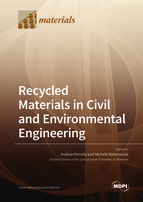Recycled Materials in Civil and Environmental Engineering
A special issue of Materials (ISSN 1996-1944). This special issue belongs to the section "Construction and Building Materials".
Deadline for manuscript submissions: closed (20 April 2022) | Viewed by 50327
Special Issue Editors
Interests: material recycling; inorganic compounds; wastewater treatment; photocatalytic materials; biopersistent pollutants; nanocomposites
Special Issues, Collections and Topics in MDPI journals
Interests: air monitoring; health and environmental risk analysis; innovative materials for environmental applications; remediation of contaminated sites; waste management; wastewater reuse
Special Issues, Collections and Topics in MDPI journals
Special Issue Information
Dear Colleagues,
Waste represents a huge reserve of resources which, after appropriate management, can guarantee a sustainable and continuous supply of materials and energy over the years.
Waste management includes the activities aimed at managing the entire waste process which involves the collection, transport, treatment (recovery or disposal), reuse and recycling of waste materials in order to reduce the effects on human health and the impact on the environment.
The proper management of hazardous and non-hazardous waste deriving from civil and industrial operations is the basis of the principles of Circular Economy that the European Union has indicated in specific Regulations and Directives devoted to the control of the entire waste cycle, from production to disposal, with specific attention to recovery and recycling.
The aim of this Special Issue is to collect recent researches devoted to the collection, transport, treatment and disposal of wastes with specific reference to the recycling and reuse of the materials in the field of the Civil and Environmental Engineering.
To this end, it is our pleasure to invite you to submit a manuscript for this Special Issue.
Full papers, communications, and reviews are all welcome.
Prof. Dr. Andrea Petrella
Prof. Dr. Michele Notarnicola
Guest Editors
Manuscript Submission Information
Manuscripts should be submitted online at www.mdpi.com by registering and logging in to this website. Once you are registered, click here to go to the submission form. Manuscripts can be submitted until the deadline. All submissions that pass pre-check are peer-reviewed. Accepted papers will be published continuously in the journal (as soon as accepted) and will be listed together on the special issue website. Research articles, review articles as well as short communications are invited. For planned papers, a title and short abstract (about 100 words) can be sent to the Editorial Office for announcement on this website.
Submitted manuscripts should not have been published previously, nor be under consideration for publication elsewhere (except conference proceedings papers). All manuscripts are thoroughly refereed through a single-blind peer-review process. A guide for authors and other relevant information for submission of manuscripts is available on the Instructions for Authors page. Materials is an international peer-reviewed open access semimonthly journal published by MDPI.
Please visit the Instructions for Authors page before submitting a manuscript. The Article Processing Charge (APC) for publication in this open access journal is 2600 CHF (Swiss Francs). Submitted papers should be well formatted and use good English. Authors may use MDPI's English editing service prior to publication or during author revisions.
Keywords
- Waste management
- Recycled materials
- Innovative materials
- Sustainability
- Environmental remediation
- Composites
- Civil engineering
- Environmental engineering








